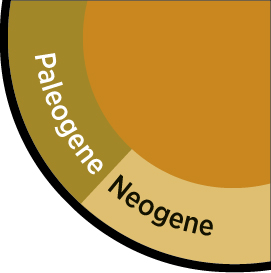

Several lineages of marine mammals, from otters to whales, live in the sea today. Oceans offer abundant sources of protein, and, starting 55 million years ago, mammals began to overhaul many of their organs and body functions to survive there. Moving landmasses and atmospheric changes caused the oceans to cool about 34 million years ago, and currents carried up nutrients from the depths—which became the basis for new marine ecosystems. Phytoplankton and zooplankton flourished and offered a rich food supply. Baleen whales evolved an efficient feeding technique and eventually became Earth’s largest animals ever. Distant relatives of elephants, the sirenians, or sea cows, also evolved in the Eocene. Represented by modern manatees and dugongs, sea cows once were more diverse, with amphibious and aquatic forms whose dense ribs acted as ballast.
Represented by modern manatees and dugongs, sea cows once were more diverse, with amphibious and aquatic forms whose dense ribs acted as ballast.

The pig-sized sea cow Pezosiren portelli could walk on land but probably moved more easily in water, like a hippo. Lacking hind legs, Metaxytherium floridanum was fully aquatic, with flippers.

The largest living whales gulp water and pass it through comblike keratin plates of baleen on their jaws to strain food. Diorecetus hiatus was among the first whales with baleen.

Acrophoca longirostris, from the Miocene Epoch of Peru, is related to modern monk seals. Pinnipeds (seals and sea lions) first appeared in the previous epoch, the Oligocene.